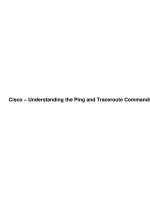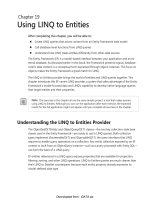Understanding Entities Through Objects
Bạn đang xem bản rút gọn của tài liệu. Xem và tải ngay bản đầy đủ của tài liệu tại đây (392.67 KB, 19 trang )
Chapter 16
Understanding Entities Through
Objects
After completing this chapter, you will be able to:
Access the properties of an entity through a standard object instance
Add, update, and delete database content by modifying object properties
Carry out query-like actions using standard method calls
One of the main advantages of the Entity Framework (EF) is that you can manage database
content using standard .NET objects that reflect the conceptual nature of the data. Behind
the scenes, various XML models, generated language code blocks, and provider interactions
make this possible. But the complexity exists solely to fulfill the promise of providing simplic-
ity in handling the main business logic of your application. Imagine being able to modify the
Name property of a Customer object in code and have that change propagate to the database—
all without having to write any of the code to make that happen.
This chapter introduces Object Services, the part of the Entity Framework that makes that
promise a reality. This Framework layer makes the transition from database to model to
objects—or vice versa—possible. In a way, the Entity Framework is the Object Services layer
because that layer is responsible for the core functionality of the Framework. Visual Studio
makes working with the Framework easy because access to its functionality is enhanced by
visual designers and Entity SQL scripts. This chapter focuses on the objects themselves; you’ll
see how to add, modify, and remove them in a way that directly affects the external data
store.
Note
The exercises in this chapter all use the same sample project, which is a tool that provides
editing features for a table of customers. While you will be able to run the application after each
exercise, the expected results for the full application might not appear until you complete all
exercises in the chapter.
Managing Entity Data Through Objects
Object Services manages the entire lifetime of data through the Entity Framework, from
determining how to translate the storage-layer model into the appropriate provider-level
actions, to shuttling data through the model and into usable .NET objects. Earlier chapters
Dwonloaded from: iDATA.ws
268
in this book introduced some of these modeling concepts. This time, the focus is on the last
part: exposing data through objects.
Accessing Entity Data Through Objects
The object layer source code that Object Services generates from the Conceptual Schema
Definition Language (CSDL)-based conceptual model consists of classes that derive from a set
of generic base classes. Each conceptual model element has some object-level counterpart
that appears as C# or Visual Basic source code in the ModelName.Designer.cs or ModelName.
Designer.vb file. The following base classes play key support roles in implementing the con-
ceptual model in code:
System.Data.Objects.DataClasses.EntityObject This is the base class for all enti-
ties. If your entity model includes a Customer entity, the generated code includes a
Customer class that derives from this EntityObject class. Individual entity properties ap-
pear as standard .NET properties within the derived class.
System.Data.Objects.DataClasses.ComplexObject When an entity includes a
complex type (such as the Address complex type crafted in the “Entity Data Model
Designer” section on page 230 of Chapter 14, “Visualizing Data Models”), that type de-
rives from the ComplexObject base class.
System.Data.Objects.ObjectSet(Of TEntity) Entities—the table-style collection of
individual entity instances—derive from this generic base class. ObjectSet implements
the IEnumerable interface for a collection-like experience.
System.Data.Objects.ObjectQuery(Of T) Although generated entity objects are not
based on this class, it still plays a key role in Entity Framework data activities. Any time
you query entity data—whether through an Entity SQL query, the LINQ tools discussed
later in this book, or the query builder methods introduced in the second half of this
chapter—the returned results exist as some form of ObjectQuery. It also serves as the
base class for ObjectSet(Of TEntity).
System.Data.Objects.ObjectContext This is the class-based embodiment of an en-
tire conceptual model, also called the entity container. The generated entity container
provides access to all entity and association instances within your application. You must
create an instance of a derived ObjectContext to interact with Entity Framework data.
Additional classes implement associations, association endpoints, and other class-based ex-
pressions of conceptual model elements. The derived classes also draw on the storage and
mapping layers to carry out the various data activities requested by your code.
The following code, already introduced in an earlier chapter, shows some typical statements
used to access external data through model-generated objects:
Dwonloaded from: iDATA.ws
Chapter 16 Understanding Entities Through Objects
269
C#
// ----- Always start by creating an object context. Create an instance of
// either ObjectContext, or of the derived entity container class.
using (SalesOrderEntities context =
new SalesOrderEntities(GetConnectionString()))
{
// ----- Option 1: Derived entity collections expose contained
// entity sets directly.
results = context.Customers;
// ----- Option 2: The CreateObjectSet method returns all entity
// instances for the named entity type.
results = context.CreateObjectSet<Customer>();
// ----- Option 3: Run an Entity SQL query to retrieve some
// or all entity instances.
results = new ObjectQuery<Customer>(sqlText, context);
// ----- Option 4: Use query builder methods, shown later.
// ----- Option 5: Use LINQ, shown later.
}
Visual Basic
' ----- Always start by creating an object context. Create an instance of
' either ObjectContext, or of the derived entity container class.
Using context As New SalesOrderEntities(GetConnectionString())
' ----- Option 1: Derived entity collections expose contained
' entity sets directly.
results = context.Customers
' ----- Option 2: The CreateObjectSet method returns all entity
' instances for the named entity type.
results = context.CreateObjectSet(Of Customer)()
' ----- Option 3: Run an Entity SQL query to retrieve some
' or all entity instances.
results = New ObjectQuery(Of Customer)(sqlText, context)
' ----- Option 4: Use query builder methods, shown later.
' ----- Option 5: Use LINQ, shown later.
End Using
Dwonloaded from: iDATA.ws
270
Microsoft ADO.NET 4 Step by Step
Depending on how you configured your conceptual model, this code might not actually
retrieve any data from the database because by default the Entity Framework defers data ac-
cess until the data is needed. Therefore, in many cases, you must access individual entities or
their properties to initiate a true database query.
After you have a set of entity instances, you can scan through them as you do with any other
collection. The entity properties of each instance method appear as standard .NET class
properties, so you can access them from code just like any other strongly typed property.
C#
foreach (Customer oneCustomer in results)
{
SendInvoicesToCustomer(oneCustomer.ID, oneCustomer.FullName);
}
Visual Basic
For Each oneCustomer As Customer In results
SendInvoicesToCustomer(oneCustomer.ID, oneCustomer.FullName)
Next oneCustomer
Complex types use a multidotted property notation.
C#
VerifyPostalCode(oneCustomer.Address.PostalCode);
Visual Basic
VerifyPostalCode(oneCustomer.Address.PostalCode)
This same syntax also works for content at the other end of a navigation property.
C#
// ----- Assume that State is a navigation property.
location = oneCustomer.Address.City + ", " +
oneCustomer.Address.State.Abbreviation;
Visual Basic
' ----- Assume that State is a navigation property.
location = oneCustomer.Address.City & ", " &
oneCustomer.Address.State.Abbreviation
Dwonloaded from: iDATA.ws
Chapter 16 Understanding Entities Through Objects
271
Modifying Entity Data Through Objects
Accessing data through properties is great, but if that is all the Entity Framework could do,
it wouldn’t be a tremendous improvement over standard ADO.NET. Fortunately, the Entity
Framework also supports data updates. Entities and properties you retrieve through the con-
text are fully editable—assuming that the underlying database elements are editable.
The entity container supports updates to existing entity properties, the addition of new en-
tity instances, and the removal of existing entity instances. All changes propagate back to the
database, and all take into account the constraints and business logic rules you impose on
the conceptual layer, the storage layer, the mapping layer, and the external data store.
Modifying existing properties is the easiest action to take. After retrieving an entity, you
modify it by simply setting one of its properties to the new value.
C#
oneCustomer.AnnualFee += 50;
Visual Basic
oneCustomer.AnnualFee += 50
Just as with ADO.NET, you must take one additional step that is needed to accept all pend-
ing changes. To accept changes in the Entity Framework, call the SaveChanges method of
the active context object. This completes the update process and persists all changes to the
underlying data source.
C#
context.SaveChanges();
Visual Basic
context.SaveChanges()
Adding new entities is a little more involved, but it parallels what you would normally do with
a collection of objects in .NET. To add a new Customer entity to the model, and ultimately to
the database table or tables that manage customer data, follow four simple steps:
1. Create a new instance of the Customer entity.
2. Fill in its properties.
3. Add the new entity instance to the context or the context’s exposed set of customers.
4. Call the context object’s SaveChanges method.
Dwonloaded from: iDATA.ws
272
Microsoft ADO.NET 4 Step by Step
Here’s an example that adds a new customer:
C#
using (SalesOrderEntities context =
new SalesOrderEntities(connectionString))
{
// ----- Step 1: Create a new Customer instance.
Customer oneCustomer = new Customer();
// ----- Step 2: Fill in the properties.
oneCustomer.FullName = "Fourth Coffee";
// ...and so on...
// ----- Step 3: Add the Customer to the context.
context.AddObject("Customers", oneCustomer);
// ...or...
context.Customers.AddObject(oneCustomer);
// ----- Step 4: Confirm the change.
context.SaveChanges();
}
Visual Basic
Using context As New SalesOrderEntities(connectionString)
' ----- Step 1: Create a new Customer instance.
Dim oneCustomer As New Customer
' ----- Step 2: Fill in the properties.
oneCustomer.FullName = "Fourth Coffee"
' ...and so on...
' ----- Step 3: Add the Customer to the context.
context.AddObject("Customers", oneCustomer)
' ...or...
context.Customers.AddObject(oneCustomer)
' ----- Step 4: Confirm the change.
context.SaveChanges()
End Using
The ObjectContext.AddObject method accepts the name of the entity set (normally the plural
name of the entity) and the new entity instance. Alternatively, you can call AddObject from
the existing collection (as in context.Customers.AddObject), passing only the new entity in-
stance as an argument.
Dwonloaded from: iDATA.ws
Chapter 16 Understanding Entities Through Objects
273
Note
Each generated entity exposes two events for each core property: OnPropertyChanging
and OnPropertyChanged, where the “Property” portion matches the associated property name.
Use these events to add appropriate business logic to any entity modifications.
Your code is responsible for supplying all required property values (those that don’t accept
NULL values and that don’t have defaults). If neither the conceptual model nor the underlying
database provides primary key values, your code must supply them as well.
Note
If you neglect to call SaveChanges, not only will the changes not be persisted to the data-
base but you will also not receive any warning about the unsaved content.
To remove an existing entity from the model, call the DeleteObject method—the counterpart
of AddObject—passing it the instance to be deleted.
C#
// ----- Delete a Customer from the context.
context.DeleteObject(oneCustomer);
// ...or...
context.Customers.DeleteObject(oneCustomer);
Visual Basic
' ----- Delete a Customer from the context.
context.DeleteObject(oneCustomer)
' ...or...
context.Customers.DeleteObject(oneCustomer)
If an entity or one or more of its underlying database tables are configured to cascade de-
letes, other related entities or data values can be removed in response to a DeleteObject call.
Be sure to call SaveChanges after completing one or more entity adds, updates, or deletes. If
saving your data modifications causes other data side effects (perhaps due to triggers at the
database level), you can call the context object’s Refresh method to force an eventual reload
of any new or modified values.
C#
context.Refresh(RefreshMode.StoreWins);
Visual Basic
context.Refresh(RefreshMode.StoreWins)
The Refresh method includes a RefreshMode parameter that tells the method how to deal
with data conflicts between the data source and the local EF model’s content. Passing a
Dwonloaded from: iDATA.ws









